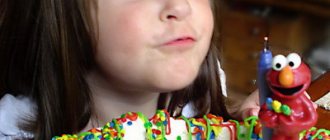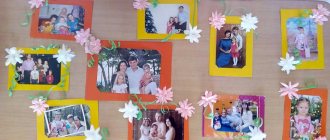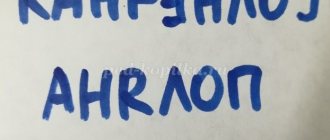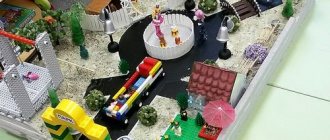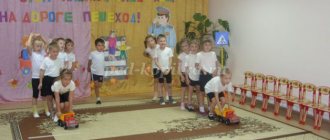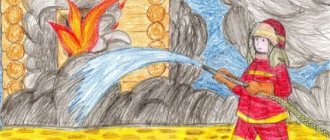Preview:
Goal: to cultivate in children love for the Motherland, hometown; instill in children a sense of pride in their city, their country.
- Arouse in children interest in Russian folklore, in the rich world of human emotions.
- To cultivate in children love and affection for family, loved ones, their home, their hometown, kindergarten.
- Enrich children with new experiences.
- To create a good mood in children, emotional responsiveness, high activity, and a desire to demonstrate their knowledge and skills.
- Learning poems, songs about the Motherland and the city, children's dances.
- In the group, hold a family creativity competition “Happy Birthday, beloved city.”
- Collecting photographic materials and preparing a presentation for the holiday “Me and My City.”
Event scenario
(The phonogram of the song “Russia” sounds softly).
Children with emblems on their chests “I love my city” enter the hall, decorated with family crafts and drawings for the anniversary of the city of Smolensk.
Hello, dear Smolensk residents! Today is city day, which means that the holiday has come to every home, because the history of any city is created by the people who inhabit it. On this day, we wish you, dear fellow countrymen, happiness and health, goodness and joy.
Why do we guys love our Fatherland? We call her beloved and dear. She is the most precious thing in life, She is always with you, with me!
Child: (girl in Russian national costume)
There is no more beautiful Motherland in the world. There is no dearer homeland in the world. Here it is, called Russia, stretching from the seas to the seas.
Child (in a knight costume):
Like the song of boundless Russia,
The names of cities sound
But still the most beautiful
I have a city, friends.
How much original, native things the native town contains! It is dearer to us than any city - a small corner of Greater Russia.
Children perform the dance “The Happiness of the Russian Land...” (words and music by E. Plotnokova)
There is a beautiful city on the Dnieper, I will call it native. It is very big and green - its name is Smolensk. I love its large parks and the river embankment. Smolensk - you are the song of Russia, the Pearl of the Russian land.
Guys, have you noticed how smart, washed up after the autumn rain our city woke up today, how clean and beautiful our streets are.
Tomorrow there will be folk festivals and concerts in city parks and squares. And in the evening, festive fireworks will bloom over the city.
Do you guys know what holiday our city will celebrate? (children's answers)
Right! Tomorrow is our city's birthday.
Let's take a walk along our streets right now. But this will not be a simple walk, but a photo walk.
(Children watch the presentation “Me and my city”)
(After watching, the presenter invites the children to sing the song “Curious Citizen”; parents are invited to sing along.)
Children perform the song “Curious Citizen” to the melody of the song “Blue Car” by V. Shainsky.
1. “If for some reason I’m not in the mood, if I feel sad again, I take my friends with me and a handful of sweets and go for a walk around the city.
CHORUS: In the city, in the city, life is always in full swing, There is no time for our city to be bored. It’s great, it’s great, and I don’t care about the melancholy, I want to know everything about the city.
2. Why was the street named like this? And why was it named highway? The whys are pouring out of me like a river, maybe I can figure out what’s what?
3. How many areas do we have and how many schools? And what kind of museum opened here? I haven’t found the answers to everything yet, but I want to find them quickly.
Guys, we live in a city in which many houses, educational institutions, shops and other buildings are being built. To build a house, many people do this work, each doing their own professional job.
Growing floor by floor,
And with every passing hour,
Higher, higher is the new house.
So now you will try to build your own houses from a constructor.
A relay race is being held: “Who can build a house faster?” (the competition is held together with parents).
Well done, you showed your abilities and built very beautiful buildings. Now let's see if you know the sights of our city.
Dad takes the baby to visit. Where? We'll ask him now.
There, where many children frolic in the company of friends. Oh, no! Where many friends frolic in the company of children. Confused. Well, in general it’s like this: he’s taking his daughter to... ( kindergarten)
Child: Is this just a wonderful house? A hundred kids in that house. The kids are very happy at home! This is our favorite kindergarten.
Child: This house has everything for us: fairy tales, songs, games, dance. Here they teach you to say thank you and love semolina porridge!
Children perform the dance “Oh, life is good in kindergarten”
And now it's time to start the game.
(quiz with parents):
Today we congratulate all citizens on City Day, which we celebrate on September 25 and dedicate a quiz to this event.
The presenter asks questions. For the correct answer, the participant is awarded a chip.
- What is the name of the city where we live?
- What are the people of our city called?
- What is the name of the street where you live?
- What is your house number?
- How many floors are there in your house?
- Give your apartment number.
- What are your parents' names?
Now let's train our memory and ingenuity.
In this competition, the presenter reads famous poems by A. Barto. But he reads to the last line or word. And the children finish the verse, with the help of their parents.
Competition "Take the dolls to kindergarten."
The doll is placed on the stroller, and the children take it to kindergarten. This competition is held in teams, against time. The main thing is to quickly transfer the dolls to educators, whose role is played by parents.
Competition "Taste of Summer". Children are blindfolded and offered to taste different berries and fruits. For example, a piece of pear, grapes, banana, lemon and so on. And the children must taste what they were given. Children will eat deliciously and be able to practice their taste skills.
I'm sitting by the kettle, watching over the hot tea. I'll treat you to pies, but first I'll dance.
The teacher invites children and parents to a general round dance
The dance “Round Song” is performed (from the cartoon “Smeshariki”)
That's the end of our musical tour of the city. Let's, friends, love our hometown! Appreciate it, protect it and decorate it! Guys, your parents have prepared anniversary chocolate medals for you today. (Children are awarded medals to the anthem of the city of Smolensk and the children go to the group to drink tea).
Municipal budgetary preschool educational institution
Fun for City Day in kindergarten.
Entertainment in the senior group “My City”
Natalia Gribanova
Entertainment in the senior group “My City”
Goals: to reveal the historical concept of “ city ”
;
introduce you to different cities , determine their distinctive features: continue to introduce you to your hometown , enriching and expanding knowledge about memorable places of the city : cultivate love for your hometown : develop speech by teaching writing stories: introduce oral folk art through proverbs and sayings about the Motherland, native land.
Planned results: can talk about his hometown , independently come up with a short story on a given topic; able to use simple symbols and diagrams
Materials and equipment: photographs of the sights of your hometown ;
Content
organized children's activities
1. Introductory word from the teacher.
– Today we will go on a trip. But before you set off, you need to think about what to take with you. Why do you think I brought the card? What do these points represent on the map? Why are the dots different - big and small?
– Do you know why a place where many people live is called a city ? Say the word " city "
slowly, listen to this word.
In fairy tales and epics, the city was called the city in the ancient way : Kiev-grad, Moscow-grad. In ancient times, there were frequent wars for land, and in order to protect themselves from enemies, people fenced themselves with high fences and then erected fortresses. Do you hear a familiar word in the words “
fence ” ,
“fenced”
?
Since then, the fenced area has been called a city . Thus, from the ancient word “hail”
the modern word
“
city ” .
2. Traditions of the native land.
– There are many cities . Everyone has their own name, just like a person. Cities are young and old , noisy and calm. What cities have you visited ?
– Admire our city from above (exhibits photographs, illustrations
– You and I are one big friendly family living in the same city . They say about us that they are fellow countrymen.
– What city do we live ? In Moscow there are Muscovites, in Tomsk there are Tomsk residents, but what should the residents of our city ?
– We love our hometown , our land. The Russian people have been glorifying their land for a long time. There are a lot of proverbs and sayings about this among people.
• Everyone loves their own side.
• Where someone is born, that is where they will come in handy.
• Houses and walls help
• Your own land is sweet in a handful.
• You can even dream about your native land.
— Come on, let’s collect the flag of our city
Children take pictures and make a flag out of them
-On a big planet
Countless cities,
On the Tom River
There is the best one!
This is our favorite city of Belogorsk !
Club hour “My city, my land.”
MBDOU d/s No. 96
Club hour on the theme “My city, my land.”
Goals:
- systematization of children’s knowledge about their hometown, region
- awaken in children a feeling of love for their city, region, respect for its
traditions and customs;
- cultivate respect for the culture of other peoples of the region;
- develop the need for independent exploration of the surrounding world
by studying the cultural heritage of different peoples.
Tasks:
- To instill in children independence and responsibility for their actions.
- To develop children’s desire to express their attitude towards the environment, to independently find various speech means for this.
- Acquire your own life experience, experiences necessary for self-determination and self-regulation.
- Learn to take initiative in caring for others, to be grateful for help and signs of attention.
- Teach children to resolve controversial issues and resolve conflicts.
- Learn to plan your actions and evaluate their results.
- Teach children to politely express their request and thank them for the service provided.
- Encourage the child’s attempts to consciously share various impressions with the teacher and other children.
- Develop the ability to plan your actions and evaluate their results.
- To foster independence and responsibility in children.
- Learn to navigate around the kindergarten premises.
- Foster friendships between children of different ages.
- Reinforce the rules of behavior.
- Teach children how to resolve controversial issues and resolve conflicts.
Venue of the “Club Hour”: groups of pupils of secondary “A” and senior “B”, music and sports halls, offices of a psychologist, speech therapist and Ossetian language MBDOU kindergarten No. 96, Vladikavkaz
Participants: pupils of preparatory group “A”, senior group “B” and middle group “A”, parents.
Additional assistance in organizing the event: kindergarten staff, psychologist, speech therapist, physical education and Ossetian language instructors, music worker, teachers.
Club hour type: themed
Time and date: 10.00–11.00 November 10, 2022.
Resource support for the reflective circle: bags with red circles, a glowing heart, a candle, pillows, signs along the corridors and on the doors of the rooms.
Preliminary work among parents:
— inform parents about how, when and at what time the “Club Hour” will be held and how it will affect children;
— identification of prohibited places and familiarization with prohibited signs for the safety of children.
Preliminary work among teachers: prepare events for holding a club hour.
Rules aimed at the formation and development of communicative, moral, volitional qualities, self-regulation, and the ability to plan one’s actions help organize a safe and effective “Club Hour”.
For violating the rules of the club hour, the student loses the red circle that he has in his purse, there are three of them; deprivation of all the circles leads to missing the next club hour.
The rules are clear and simple:
- Say "Hello!" when meeting and “Goodbye” when parting;
- If you took a toy to play, put it back when you leave;
- Do not take toys from other children if they took it first;
- Speak calmly;
- Walk calmly;
- Return to the group when the bell rings;
- If you don’t want to go to other groups, you can stay in your own or return to it if you’re tired;
- Finish what you start.
To maintain discipline, at the beginning of Club Hour, each child is given three tokens. By breaking any rule, the child loses the token. If during the discussion during the reflective circle it turns out that the child has no tokens left, the teacher reminds that the child will spend the next club hour in a group.
The safety of children during the “Club Hour” is ensured by kindergarten teachers.
The club hour begins and ends when the bell rings.
Club hour " My city, my land "
Everyone in the world has their own little corner. For me, believe me, this is what our quiet town has become. Before, I didn’t understand and sometimes I was sad if my mother walked us home after kindergarten. We didn't want excursions, We wanted to go on the swing! But now I’m older and my interest has awakened: About my native and glorious city Find out everything, finally. Every day I look forward to when we go for a walk, Because my mother can tell me everything: About sculptures, monuments And about the Victory monument, About athletes, masters, Famous fellow countrymen... I know everything about the city, And now I understand: We should be proud of it, our native city!
Children of preparatory group "A", senior group "B" and middle group "A" gather in the music room. At the ringing of the bell, Club Hour begins.
Children were offered 7 centers:
- Architectural Center –
in the psychologist's office, where children could build a model of the future city.
2.
Cognitive center
– located in the middle group “A”, where children
got acquainted with the history of their region and built examples of historical
family towers.
- Folk workshop
– in the senior group “B”. It was possible to make dishes (from papier-mâché) with Ossetian national ornaments.
- Tourist training center -
located in the gym.
At the tourist training center, the level of preparation of children for hiking in the mountains was checked.
- People's Laboratory -
was located in the Ossetian language classroom, where children could familiarize themselves with the national ornament and decorate scarves with them. It was also possible to make a finger theater based on an Ossetian folk tale.
- City Center
- was placed in the speech therapist’s office, where it was possible to make a city map from available material.
- Game center
-
located in the music room. Here children could voice their favorite melodies on various instruments and play Ossetian rhythmic games.
After the end of the club hour, all the participating children gather in the hall, sit in a circle on pillows and the discussion begins - “Reflective circle. At the “Reflective Circle”, children share their impressions and talk about where they have been, what they did, what they did, what they liked and what they didn’t, express their wishes and where else they would like to go
During the club hour, it was noted that the emotional background of the children increased, which led to an increase in their activity in the cognitive sphere. The knowledge acquired during the club hour became more durable. Parents were active assistants of the club hour; this helped to implement an important task of the Federal State Educational Standard for Education: increasing the competence of parents in matters of raising and educating children.
My favorite city
Municipal budgetary preschool institution of a combined type, kindergarten No. 2, Lebedyan
Report on the event dedicated to City Day
"The city we live in!"
group "Firefly".
Compiled by: teacher
Zanina L.S.
Early in the morning I get up, go to kindergarten with my mother, and sing my song about my beloved city. The birds sing along with me, the sun is shining above, and I shout: “Good morning, the best city on earth!”
In honor of the celebration of the 407th anniversary of the city of Lebedyan, thematic events were held in kindergarten No. 2:
viewing photo slides “Sights of Lebedyan” allowed you to take a virtual exciting tour of your favorite city;
the Firefly group held a quiz “I know my city, my beloved and dear”;
organized jointly with parents, the competition “My favorite city is Lebedyan!”;
During the festive event, the children listened to the recorded anthem of the Lebedyansky district performed by a CIS vocal-instrumental group, words by E.V. Kochetov, music by I.V. Dvornikov, O.V. Shurupov.
The children got acquainted with the history of our city: the first mention of the Lebedyan settlement” in 1605, the city was founded in 1613, why it has such a name, etc.
The guys remembered the names of the streets where they live, named memorable places in the city where they laid flowers during excursions (Memory Square), named places where they like to go with their family: the embankment of the Don River, the State Bridge, the museum, the Chapel of Saints Peter and Fevronia, and as befits a birthday, they said a lot of warm words and wishes to our beloved city.
The children looked at the flag and coat of arms of the city and learned the history of their origin and the meaning of the colors.
Flag of the urban settlement Lebedyan
Lebedyansky municipal district of the Lipetsk region of the Russian Federation is an identification and legal sign that serves as the official symbol of the municipality.
The flag was approved on December 24, 2009 and entered into the State Heraldic Register of the Russian Federation with the assignment of registration number 5846.
The heraldic description of the coat of arms reads: “ In an azure field on a golden land, a silver swan with raised wings with scarlet eyes, beak and paws
».
Rationale for symbolism.
The flag is designed based on the coat of arms of the urban settlement Lebedyan.
The description of the historical coat of arms reads: “At the top of the shield is the Tambov coat of arms. At the bottom is a swan bird in a blue field, meaning the name of this city.”
Afterwards, the guys independently depicted the coat of arms of our city Lebedyan.
Every happy person has his own favorite city. Most often, a favorite city or region is the place where a person was born, where he spent his childhood, because it is with childhood that most people have the kindest and most touching memories.
